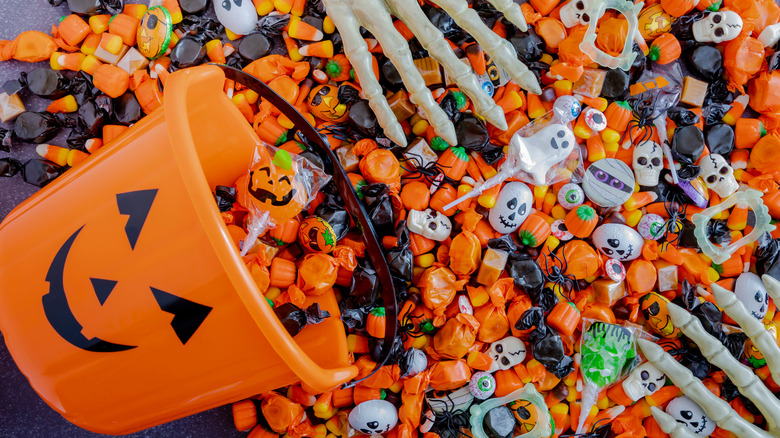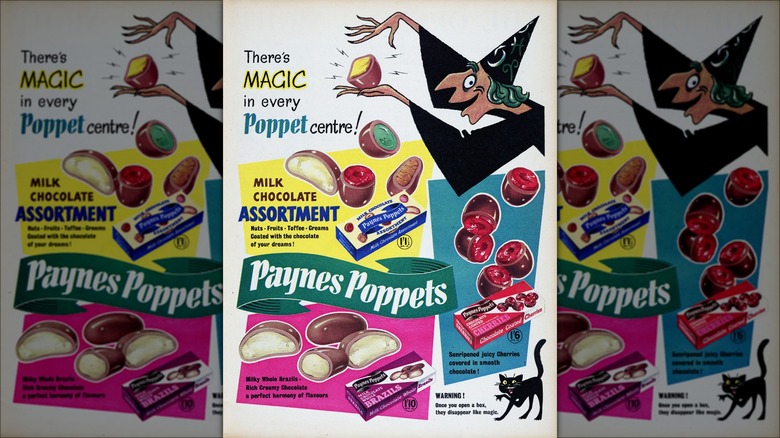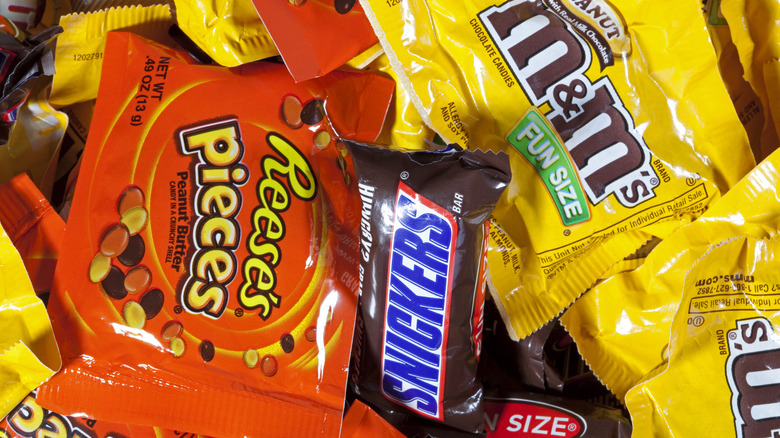The Not-So-Spooky Reason We Eat Candy On Halloween
From the day on which it's observed to the carved pumpkins we set on our doorsteps, many of Halloween's traditions can be traced back hundreds of years. But how did eating and giving out candy become associated with a holiday that's closely associated with death? Is the candy supposed to bribe the ghosts, ghouls, and spirits that take over on Halloween, as a way of begging them to leave us alone? Thankfully, the reason we eat candy at Halloween isn't as scary as all that — unless you think teenagers are scary, in which case, welcome to the club.
Halloween historian Lisa Morton shared with Martha Stewart that sweets didn't become a popular Halloween treat until the 1930s. Kansas newspaper Hiawatha World says that as early as 1914, there were reports of adolescent pranksters wreaking havoc during Halloween in the local community, and according to Morton, the pranks became more severe as the population increasingly lived in urban, rather than rural, areas. To deter this destructiveness, some community members started traditions of Halloween parades, and other community groups came up with the idea of encouraging costumes, parties, and giving out sweets, hoping these treats would distract kids from getting up to no good. In 1936, a magazine used the term "trick-or-treat" for the first time, but it wasn't until the 1950s that candy became the Halloween treat of choice, thanks to the post-war rise of convenience foods.
The move from homemade treats to store-bought sweets
In the beginning, kids who were trick-or-treating were likely to receive treats like homemade baked goods, fruits and nuts, toys, and even coins, according to History. Then, during World War II, Halloween temporarily fell out of favor, thanks to war-time rationing of things like sugar. But thanks to the rise of television, trick-or-treating came back in full swing, after being featured on some popular shows of the time like "The Adventures of Ozzy and Harriet." In 1952, the show featured an episode called "Halloween Party," which is believed to be the first Halloween-themed episode of TV ever aired, according to Yahoo.
This trick-or-treating resurgence was occurring along with the post-war rise of convenience foods, which more and more families were relying on in the 1950s. The same was true of Halloween treats. Women were more likely to opt for store-bought candy to give out on Halloween as treats rather than spending time making something from scratch. Candy corn was the first kind of candy that was explicitly advertised for Halloween starting in the 1950s, but it would be a few more years before candy completely replaced other treats.
Halloween candy then and now
Have you ever heard rumors about razor-filled apples or poisoned candies being given out on Halloween? It turns out that most of these urban legends have their root in a true, tragic event. A&E explains that in 1974 a man murdered one of his children by giving candy laced with cyanide after trick-or-treating. Strangely enough, this led to the complete take-over of store-bought Halloween candy as the only acceptable treat to give out every October, due to the perception that only candy still in its factory-wrapped packaging was safe from the tampering of evildoers. Thus, the Halloween candy industry was truly born.
These days, sweets like M&Ms, Reese's Peanut Butter Cups, and Kit Kats are the most popular Halloween candies, according to a YouGov survey. There are also new traditions, like trunk-or-treating, events where people gather in parking lots and give candy out from their cars. It's thought by some to be a safer alternative to sending kids to strangers' homes door-to-door, and tends to be popular in religious communities, too. But no matter how kids ask for or receive their treats, one thing seems certain — the tradition of eating candy on Halloween is alive and well. In 2022, CapitalOne reported that Americans spent more than $3 billion on Halloween candy, and 96% of households bought at least some Halloween candy. That's all the evidence we need that Halloween and candy still go hand-in-hand, and will be around for a long time to come.


